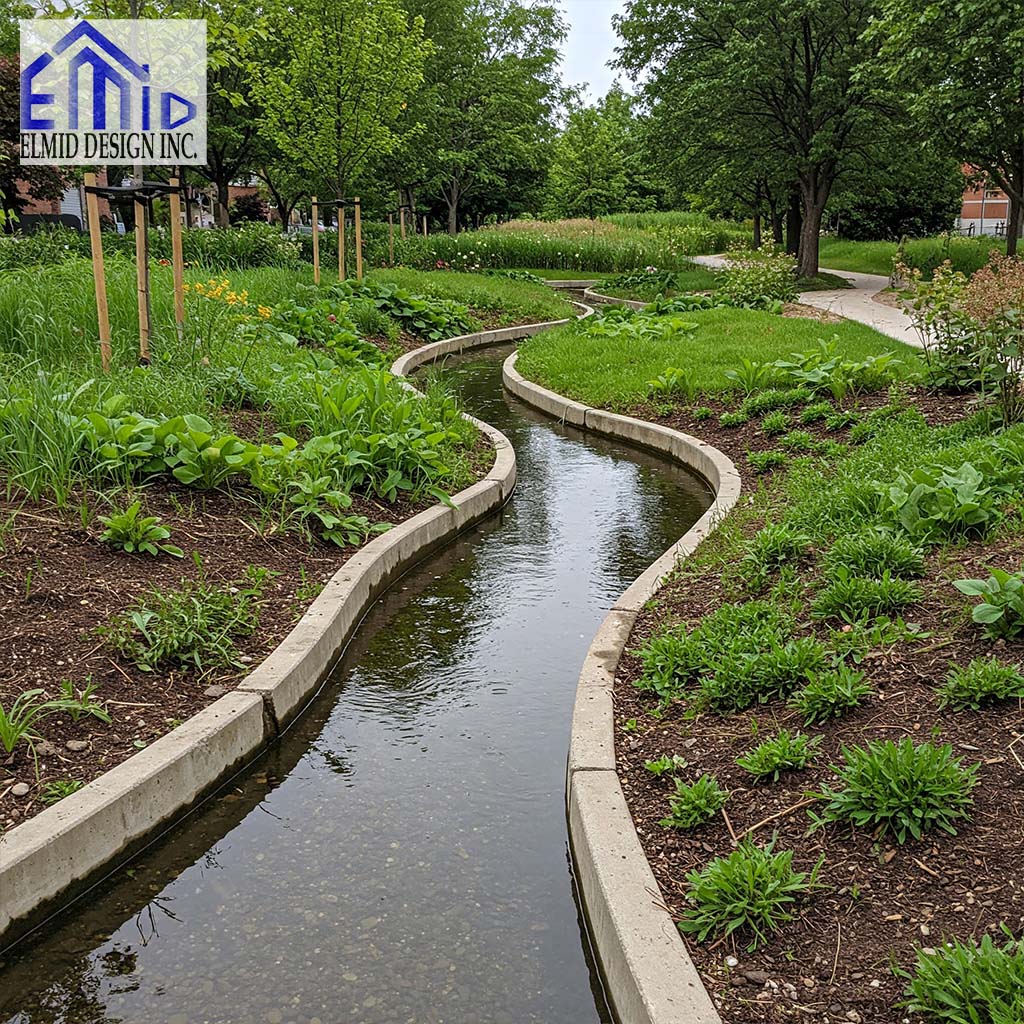Stormwater management in Markham is a growing concern as the city continues to urbanize and face more frequent storms. The City of Markham has implemented a wide-ranging plan to manage runoff, reduce flooding, and improve water quality. If you’re a property owner, a developer, or a resident trying to understand how your city handles stormwater, this guide breaks it all down in simple terms. Keep reading to learn how Elmid Design Inc, a certified engineering company recognized by Professional Engineers Ontario (PEO), plays a key role in shaping sustainable infrastructure.
[toc]
Key Takeaways
Stormwater management in Markham focuses on controlling runoff to prevent flooding and protect water resources
The city uses both engineered systems and green infrastructure to manage stormwater
Elmid Design Inc is a certified firm contributing to local stormwater and infrastructure solutions
Funding comes from a special stormwater fee introduced to support long-term maintenance
Low Impact Development (LID) strategies are becoming central to Markham’s sustainability plans
Why Stormwater Management Markham Matters More Than Ever
Word Count: 300
With increasing urban development and more extreme weather events, stormwater runoff is becoming a real problem for cities like Markham. Traditional sewer systems can’t always handle the volume of water during storms. When rain hits roads, driveways, and rooftops, it runs off quickly and can overwhelm drainage systems. That’s when flooding happens.
Stormwater also picks up pollutants like oil, chemicals, and debris. If this runoff goes untreated, it ends up in local streams and rivers. This degrades water quality and harms aquatic life. Managing this runoff is not just about avoiding floods — it’s also about protecting our environment.
That’s why the City of Markham has developed a detailed strategy to handle stormwater effectively. From massive underground pipes to nature-inspired solutions like bioswales and rain gardens, the city is investing in systems that reduce the speed and volume of stormwater.
Elmid Design Inc, an engineering firm licensed with a Certificate of Authorization from PEO, helps design these smart systems for municipal and private developments. This ensures the infrastructure meets strict engineering and environmental standards.
You’ll learn about the tools Markham uses to manage water, how they’re funded, and what’s being done to make the system more resilient in the face of climate change.

The Core Elements of Stormwater Management in Markham
Word Count: 400
Markham’s stormwater management system combines traditional infrastructure and modern green solutions. Both are essential for managing runoff during heavy rains.
The city maintains a network of 123 stormwater ponds, with more added every year. These ponds temporarily store rainwater, letting it slowly release back into streams and rivers. This reduces the chances of flooding. They also allow sediments and pollutants to settle before water flows downstream.
Apart from stormwater ponds, Markham relies on underground pipes, manholes, and catch basins to move water safely away from roads and buildings. These are the backbone of any stormwater network. But they’re not enough on their own, especially with the effects of climate change causing more intense downpours.
That’s where green infrastructure comes in. Green infrastructure refers to systems that use vegetation, soil, and natural processes to manage water. In Markham, these include:
Rain gardens that absorb runoff
Bioswales that slow water down and filter pollutants
Permeable pavements that allow water to soak into the ground
Tree box filters that treat stormwater near sidewalks and roads
Markham is increasingly adopting these techniques in public spaces and encouraging them in new developments.
One key player in bringing these ideas to life is Elmid Design Inc, a local engineering firm that incorporates both civil and environmental principles in stormwater projects. Their designs follow Markham’s Stormwater Management Guidelines, ensuring every element supports long-term sustainability.
To read more about Markham’s guidelines, the city provides full documentation on its website. You can check the city’s detailed technical requirements here.
How Markham Funds Its Stormwater Infrastructure
Word Count: 400
Managing stormwater isn’t free. It involves continuous maintenance, repairs, and upgrades to keep systems working properly. That’s why Markham introduced a dedicated stormwater fee in January 2020.
This fee applies to both residential and non-residential properties. For most homeowners, it starts at fifty dollars per year, increasing by one dollar annually. This small fee goes a long way toward maintaining the entire stormwater system.
For non-residential properties, like shopping malls or office buildings, the fee is calculated based on the property’s Current Value Assessment (CVA). It begins at twenty-eight dollars per one hundred thousand dollars of CVA, with a two percent annual increase.
You’ll see this charge added to your property tax bill. The money doesn’t go into the general budget. It goes directly toward managing stormwater infrastructure.
The funds support flood mitigation projects, maintenance of stormwater ponds, and inspection of underground systems. One major project funded by this fee is the West Thornhill flood mitigation project, which involves installing large underground storage pipes to control stormwater during storms.
You can learn more about the funding breakdown and see where your stormwater fees are going here.
Flood Control Projects and Federal Support
Word Count: 400
Markham is tackling major flood risks with help from the federal government. The city received $48.6 million from the Disaster Mitigation and Adaptation Fund to support flood control.
This funding is part of Markham’s long-term plan to prepare for more intense storms. It includes projects like the Don Mills Channel restoration, which turns a concrete channel into a more natural watercourse with vegetation and ponds that slow water and filter pollutants.
Another big effort is the West Thornhill Phase 4 Project, which focuses on installing large underground pipes that temporarily store rainwater. These projects prevent water from backing up into homes during major rain events.
By restoring natural landscapes and expanding water storage capacity, Markham is protecting thousands of homes from flooding. These projects are designed using leading engineering standards, often involving expert firms like Elmid Design Inc, who ensure all specifications meet both PEO and City of Markham regulations.

Low Impact Development: A Smarter Approach to Stormwater Management Markham
Word Count: 450
Low Impact Development, or LID, is changing how cities manage stormwater. Instead of simply moving rainwater away from buildings, LID focuses on managing water where it falls. This approach mimics natural water cycles and reduces the load on traditional infrastructure.
In Markham, LID is being used more and more in both public and private projects. The city supports LID through its planning process, encouraging developers to include LID elements in site designs. This includes rain gardens, green roofs, bioswales, and permeable surfaces that let rain soak into the ground rather than rushing into sewers.
These LID strategies help control flooding and improve water quality. When water flows slowly through soil and vegetation, it gets naturally filtered. Pollutants settle out before water reaches nearby streams or rivers.
Elmid Design Inc, a licensed firm under the Professional Engineers Ontario system, frequently uses LID techniques in their designs. Their expertise ensures that developments stay compliant with the City of Markham’s environmental goals. Whether it’s designing permeable parking lots or integrating bioswales into subdivisions, their engineering solutions help reduce the environmental impact of urban growth.
The future of stormwater management in Markham depends on expanding these green strategies. As climate change brings more unpredictable weather, LID makes the system more flexible and resilient. This approach also makes neighborhoods greener, healthier, and more attractive.
To learn more about how LID is shaping Ontario cities, the Rain Garden Wiki provides clear explanations and examples.
Maintaining Markham’s Stormwater Infrastructure
Word Count: 400
Having a stormwater system is one thing. Keeping it working is another. Markham invests heavily in maintenance to make sure every pond, pipe, and bioswale functions as intended. Poor maintenance can lead to backups, flooding, or water pollution.
Stormwater ponds must be inspected regularly. Sediment builds up at the bottom and needs to be removed. This is especially important in areas with a lot of construction or paved surfaces, where runoff carries more debris.
Underground pipes and catch basins are also inspected using cameras. If blockages or cracks are found, crews are dispatched to clean or repair them. During the fall, leaves can clog drains, so teams work proactively to keep them clear.
Green infrastructure like rain gardens and bioswales need seasonal care. Plants must be trimmed and invasive species removed. Without maintenance, these systems become overgrown or stop functioning effectively.
Public safety is part of maintenance too. Stormwater ponds may look like regular parks, but the water levels can rise quickly during storms. The city posts signs and restricts access to reduce the risk of accidents. Parents are encouraged to teach children to stay away from these ponds.
All these efforts are coordinated through the city’s stormwater operations team. The work is supported by the stormwater fee mentioned earlier. It ensures that money is available not only for building new infrastructure but also for keeping it in good shape.
To explore the full maintenance strategy, visit the city’s page on stormwater facilities.
Public Awareness and Community Involvement in Stormwater Management Markham
Word Count: 300
Markham’s success in stormwater management also relies on public awareness. Residents can play a role in reducing runoff and keeping local waterways clean. Simple actions make a big difference when done at scale.
Installing a rain barrel helps capture water from roofs. That water can then be used to water gardens instead of going into the sewer. Reducing the use of lawn chemicals prevents pollutants from being washed into storm drains during rain.
Property owners can also replace pavement with permeable materials. Gravel driveways or interlocking stone allow water to soak in. Even planting trees helps, because roots slow down and absorb rainwater.
The City of Markham runs educational programs and community events to spread this knowledge. These include rain garden workshops and environmental fairs where residents learn how to manage water on their own properties.
Elmid Design Inc also supports community outreach, partnering with local organizations to explain how engineering can solve environmental challenges. Their team provides talks at schools, contributes to local sustainability campaigns, and showcases how design makes cities more resilient.
If you want to get involved or start a stormwater-friendly project on your property, the City of Markham website provides detailed guides and support services.
Frequently Asked Questions About Stormwater Management Markham
Word Count: 450
What is stormwater and why is it a problem?
Stormwater is rain or melted snow that doesn’t soak into the ground. In cities like Markham, much of it runs off pavement and rooftops. This runoff can cause flooding and carry pollutants into local rivers and streams. Managing stormwater helps reduce damage and protect the environment.
How does Markham manage stormwater?
Markham uses a mix of traditional infrastructure like storm sewers and ponds, as well as green infrastructure such as rain gardens and permeable pavements. These systems work together to slow down, store, and filter water before it enters natural waterways.
What is the stormwater fee on my tax bill?
The stormwater fee helps fund the operation and maintenance of the city’s stormwater system. For residential properties, it starts at fifty dollars per year. For commercial properties, the fee is based on property value. This funding ensures reliable flood control and water quality protection.
Can I reduce stormwater on my own property?
Yes, you can. Installing rain barrels, building rain gardens, using permeable paving, and planting trees all help reduce runoff. These small changes contribute to a more effective citywide system.
Who designs stormwater systems in Markham?
Firms like Elmid Design Inc, which has a Certificate of Authorization from PEO, are responsible for creating compliant stormwater systems. They work with city guidelines to ensure designs meet local and provincial standards.
Are stormwater ponds safe?
Stormwater ponds are not for recreation. They fill and drain quickly, which can create unsafe conditions. Markham maintains these areas and posts signage to warn the public. It’s important to stay out of storm ponds and teach children to avoid them.

Elmid Design Inc: Leading Stormwater Management Engineering in Markham
Elmid Design Inc is a trusted engineering company in Markham, proudly holding a Certificate of Authorization from Professional Engineers Ontario (PEO). Known for delivering smart, sustainable infrastructure, Elmid Design Inc specializes in stormwater management systems that meet the highest technical and environmental standards. Their expert team works closely with municipalities, developers, and property owners to design solutions that reduce flooding, improve water quality, and support long-term urban growth. From stormwater ponds and culverts to cutting-edge Low Impact Development (LID) features like rain gardens and permeable surfaces, Elmid Design Inc combines civil and environmental engineering to protect communities and ecosystems. With a deep understanding of local bylaws and provincial regulations, their work strengthens Markham’s resilience against climate change while advancing the city’s green infrastructure goals.
Geographic Locations That We Service:
Our Licensed Professional Engineers specializing in Engineered Site Grading Plans offer the best-engineered site grading plan, lot grading and erosion plan, and drainage plan to obtain site plan approval and building permits in Ontario, including a wide range of municipalities. Each area boasts unique features and requirements, making our tailored approach essential for success.
Toronto and Surrounding Areas
In the vibrant heart of Ontario, we service Toronto (City of Toronto) and surrounding areas. Additionally, we cover Oshawa (City of Oshawa), Pickering (City of Pickering), and Clarington (Municipality of Clarington). Furthermore, our expertise extends to Ajax (Town of Ajax), Whitby (Town of Whitby), Brock (Township of Brock), Scugog (Township of Scugog), and Uxbridge (Township of Uxbridge).
Halton Region
Moving to the Halton Region, our services encompass Burlington (City of Burlington) and Halton Hills (Town of Halton Hills). Also included are Milton (Town of Milton) and Oakville (Town of Oakville).
Peel Region
In the Peel Region, we provide services in Brampton (City of Brampton), Mississauga (City of Mississauga), and Caledon (Town of Caledon).
York Region
Our services in the York Region cover Vaughan (City of Vaughan), Aurora (Town of Aurora), and East Gwillimbury (Town of East Gwillimbury). We also cater to Georgina (Town of Georgina), Markham (City of Markham), Newmarket (Town of Newmarket), Richmond Hill (City of Richmond Hill), Whitchurch-Stouffville (Town of Whitchurch-Stouffville), King (Township of King), and Bradford-West Gwillimbury (Town of Bradford-West Gwillimbury). Each municipality here offers a distinct setting, requiring our specialized approach.
Other Southern Ontario Cities and Towns
We also serve many other cities and towns in Southern Ontario. These include Hamilton (City of Hamilton), St. Catharines (City of St. Catharines), Niagara on the Lake (Town of Niagara on the Lake), Brant (County of Brant), Cambridge (City of Cambridge), Kitchener (City of Kitchener), Waterloo (City of Waterloo), and Woodstock (City of Woodstock). Furthermore, we operate in Guelph (City of Guelph), Centre Wellington (Township of Centre Wellington), Shelburne (Town of Shelburne), Orangeville (Town of Orangeville), New Tecumseth (Town of New Tecumseth), Essa (Town of Essa), Collingwood (Town of Collingwood), Wasaga Beach (Town of Wasaga Beach), Barrie (City of Barrie), Midland (Town of Midland), Orillia (City of Orillia), Ramara (Town of Ramara), Minden Hills (Town of Minden Hills), North Kawartha (Town of North Kawartha), Kawartha Lakes (City of Kawartha Lakes), Peterborough (City of Peterborough), Selwyn (Town of Selwyn), and Brighton (Municipality of Brighton).




